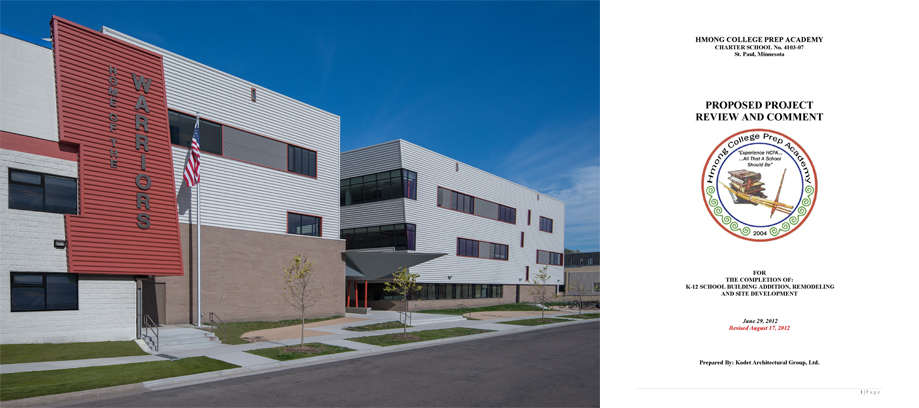Minnesota Department of Education Review & Comment Part I: Getting Started
Is your District planning a construction project? Do you think you will consider a construction project in the next 5 years? If so, then you may find yourself needing to prepare and submit a Minnesota Department of Education (MDE) Review & Comment.
What is a Review & Comment? How do you know if your project requires a Review & Comment?
This blog post is the first of two that will help you succeed in getting a positive Review & Comment by the Minnesota Department of Education. This first installment gives an overview of the Review & Comment, what is required for the submission, and who should be responsible for preparing the various submission components.

As educational architects, we have walked through the Minnesota Department of Education’s (MDE) Review & Comment process multiple times with schools and districts. From our experience, our clients are often aware of the requirement to submit a Review & Comment (R&C), but the details of the process are unclear and intimidating for first-time submitters. This blog post is written to help you determine your next steps in the R&C submission process, to give an overview of R&C requirements and who can best prepare those components, and to provide you with tips for a successful submission.
What is a Minnesota Department of Education (MDE) Review & Comment and do I need to submit one?
When a school or school district is undergoing a significant construction, the Minnesota Department of Education requires that the school entity submit information about the proposed project, including plans, financing, and the benefits of the project, to the Commissioner for review; the Commissioner returns the submission to the entity with positive, negative, or unfavorable comments. Thus, the name Review & Comment was derived.
The Minnesota Department of Education states that a school district “must not initiate an installment contract for purchase or a lease agreement, hold a referendum for bonds, nor solicit bids for new construction, expansion, or remodeling of an educational facility that requires an expenditure in excess of $500,000 per school site prior to review and comment by the commissioner.”
See the lists below to determine if your school or district is required to submit a Review & Comment:
EXEMPT
Funded by the following sources:
- General Education Revenue
- Deferred Maintenance Revenue
- Alternative Facilities Bonding and Levy Program Revenue
- Capital facilities bond proceeds
- Health and safety revenue
- Voter approved levy referendums that fund only technology-related projects
NON-EXEMPT
Projects with costs in excess of
- $500,000 if the district has a capital loan
- $2million per school site
- $2million per school site when voter-approved elections are required

My District needs to submit a Review & Comment. Who prepares what?
If you haven’t completed a Review & Comment before, it is highly recommended that you bring someone on board who has. Most often, that person is the architect or designer that worked with you to develop the pre-design or facility assessment that has led you to this point.
To help you understand what exactly the R&C submission requires, the MDE has a handy checklist online. We have broken down the submission requirements below, including who is best suited to provide the information required.
(For ease of communication, we are referring to you, the client, as the “District”, and the individual preparing the Review & Comment as the “Architect.”)
- Cover Letter – Written by the District (Superintendent)
- Project Description (Architect)
- Total Construction Cost (Architect)
- School Board Approval Statement (District)
- Brief description of project financing (District)
- If voter approved financing, include information about election for single or multiple questions, wording of questions, order of questions.
- Date of election or school board action (District)
-
-
-
- Geographic Area/Population being served (District)
- Enrollment from past 5 years
- Enrollment projections for next 5 years
- List of School Facilities (District & Architect)
- Year constructed and uses (Architect)
- Assessment of the extent to which alternate facilities are available within school district boundaries and in adjacent school districts (District & Architect)
- Specific Deficiencies of the Facility (Architect)
- Demonstrating the need for the project
- Process used to determine deficiencies
- List of deficiencies to be addressed by proposed project
- Specific benefits of proposed project
- Project Description (District & Architect)
- Specifications of site/outdoor space (Architect)
- Square footage for all spaces (Architect)
- Estimated expenditures for project (Architect)
- Estimated change in facility operating costs (District & District Financial)
- Project schedule and dates (Architect & District)
- Source of Project Financing (District & District Legal/Financial)Proposal Document – Assembled by Architect
- Documentation regarding Building & Site Obligations by District & Architect (District & Architect)
- (This is a series of forms from the MDE)
- Statement regarding Extensive Renovation/Remodeling that the School Board has: (District & Architect)
- Discussed cost data
- Discussed facility replacement versus renovation
- Determined that projected costs do not exceed 60% of replacement value of facility
- Determined that facility renovation is in the best interest of the District
- Geographic Area/Population being served (District)
-
-
We hope that this information gives you a sense of understanding and confidence as you embark on the Review & Comment process! Overall, the process is helpful for Districts to fully understand and clearly summarize the project ahead, and the information gathered can be useful for the District’s PR and press release needs.
Stay tuned for our next installment of this series debuting in mid-September: Tips for a Positive Review & Comment! We are confident that if you employ the tips we give you, you will receive a positive Review & Comment.
If you want a copy of the next installment early, please contact the author at clonsbury@kodet.com (note: contacting us will not obligate you to a monthly newsletter or mailings).
